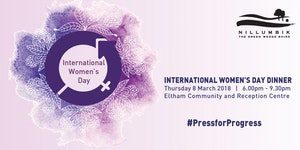On March 8 in 1911, International Women’s Day is launched in Copenhagen, Denmark, by Clara Zetkin, leader of the Women’s Office for the Social Democratic Party in Germany.
International Women’s Day (IWD), originally called International Working Women’s Day is marked on the 8th of March every year. It is a major day of global celebration of women. In different regions the focus of the celebrations ranges from general celebration of respect, appreciation and love towards women to a celebration for women’s economic, political and social achievements.
Started as a Socialist political event, the holiday blended in the culture of many countries, primarily Eastern Europe, Russia, and the former Soviet bloc. In many regions, the day lost its political flavour, and became simply an occasion for men to express their love for women in a way somewhat similar to a mixture of Mother’s Day and St Valentine’s Day. In other regions, however, the original political and human rights theme designated by the United Nations runs strong, and political and social awareness of the struggles of women worldwide are brought out and examined in a hopeful manner.
The first IWD was observed on 19 March 1911 in Germany following a declaration by the Socialist Party of America. The idea of having an international women’s day was first put forward at the turn of the 20th century amid rapid world industrialization and economic expansion that led to protests over working conditions.
In 1910, Second International held the first international women’s conference in Copenhagen (in the labour-movement building located at Jagtvej 69, which until recently housed Ungdomshuset). An ‘International Women’s Day’ was established. It was suggested by the important German Socialist Clara Zetkin, although no date was specified. The following year, 1911, IWD was marked by over a million people in Austria, Denmark, Germany and Switzerland, on March 19. In the West, International Women’s Day was first observed as a popular event after 1977 when the united Nations General Assembly invited member states to proclaim March 8 as the UN Day for Women’s Rights and International Peace.
Demonstrations marking International Women’s Day in Russia proved to be the first stage of the Russian Revolution of 1917.
Following the October Revolution, the Bolshevik Alexandra Kollontai persuaded Lenin to make it an official holiday in the Soviet Union, and it was established, but was a working day until 1965. On May 8, 1965 by the decree of the USSR Presidium of the Supreme Soviet International Women’s Day was declared a non working day in the USSR “in commemoration of the outstanding merits of Soviet women in communistic construction, in the defense of their Fatherland during the Great Patriotic War, in their heroism and selflessness at the front and in the rear, and also marking the great contribution of women to strengthening friendship between peoples, and the struggle for peace. But still, women’s day must be celebrated as are other holidays.”
The campaign theme for is #PressForProgress
With the World Economic Forum’s 2017 Global Gender Gap Report findings telling us that gender parity is over 200 years away – there has never been a more important time to keep motivated and #PressforProgress. And with global activism for women’s equality fuelled by movements like #MeToo, #TimesUp and more – there is a strong global momentum striving for gender parity.
And while we know that gender parity won’t happen overnight, the good news is that across the world women are making positive gains day by day. Plus, there’s indeed a very strong and growing global movement of advocacy, activism and support.
So we can’t be complacent. Now, more than ever, there’s a strong call-to-action to press forward and progress gender parity. A strong call to #PressforProgress. A strong call to motivate and unite friends, colleagues and whole communities to think, act and be gender inclusive.
International Women’s Day is not country, group or organisation specific. The day belongs to all groups collectively everywhere. So together, let’s all be tenacious in accelerating gender parity. Collectively, let’s all Press for Progress.
IWD campaign theme continues all year
March 8 sees the annual IWD campaign theme kick off for the year ahead, although many groups around the world adopt and promote the campaign theme from early in the year. The IWD campaign theme provides a unified direction to guide and galvanize collective action. The campaign theme does not end on International Women’s Day. It’s just the start. Throughout the year many groups worldwide adopt the IWD campaign theme for further campaign work, gender-focused initiatives, continuing activity and events. A great example of this was in 2017 when the USA Women’s Hockey Team went on to adopt the #BeBoldForChange IWD campaign theme to later rally for equal pay, boycotting the national finals unless a suitable deal was struck. Many fans and further teams supported the campaign.
Collectively we can all play a part
Collective action and shared responsibility for driving gender parity is what makes International Women’s Day successful. Gloria Steinem, world-renowned feminist, journalist and activist once explained “The story of women’s struggle for equality belongs to no single feminist nor to any one organisation but to the collective efforts of all who care about human rights.”
Started by the Suffragettes in the early 1900’s, the first International Women’s Day was celebrated in 1911. International Women’s Day belongs to all communities everywhere – governments, companies, charities, educational institutions, networks, associations, the media and more. Whether through a global conference, community gathering, classroom lesson or dinner table conversation – everyone can play a purposeful part in pressing for gender parity.
So make International Women’s Day YOUR day and do what you can to truly make a positive difference for women. Press for Progress!

